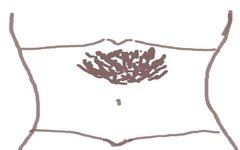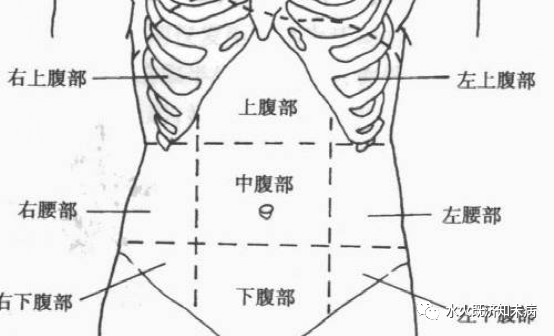
Abdominal diagnosis, also known as abdominal palpation, is a part of the diagnostic process in Traditional Chinese Medicine (TCM). It is aimed at determining the condition of deficiency or excess to guide treatment strategies, differing from modern medical examinations that focus on the morphology of organs or the presence of tumors. However, it is essential to learn about the palpation techniques for organs such as the liver, spleen, and kidneys, as well as methods for tumor examination, while this article will primarily focus on the unique aspects of TCM abdominal diagnosis.When beginning abdominal diagnosis, the patient’s clothing should be loosened as much as possible, and they should lie supine with their legs extended and arms resting at their sides or gently crossed over their chest without applying pressure. If pressure is applied to the abdomen, it may lead to misdiagnosis of conditions such as chest fullness or abdominal rigidity, making it difficult to auscultate for abdominal sounds. Therefore, I recommend performing an initial abdominal examination with the patient’s legs straight, followed by bending the knees to relax the abdominal muscles for a second examination to avoid misdiagnosis.During abdominal diagnosis, the physician should position themselves on the patient’s left side and use their right hand for examination, which is the standard practice, although examination from the right side is also acceptable. When assessing for symptoms of lower abdominal tension, the right side position may be more convenient.It is important for the physician to ensure their hands are warm before beginning the examination. Cold hands can cause the abdominal wall to contract upon contact, hindering the examination. Additionally, if the physician applies pressure with their fingertips at the start of the examination, it may cause discomfort or hardness in the abdomen, affecting the diagnosis. Therefore, it is best to start by gently stroking the abdomen with the palm of the hand from the chest downwards, which allows for simultaneous assessment of the abdominal wall’s thickness, moisture, dryness, and pulsation before proceeding with detailed examination.1. Abdominal StrengthThe most critical aspect of abdominal diagnosis is determining whether the abdominal strength is “excess,” “between excess and deficiency,” or “deficient.” This requires the use of the entire palm to gently or firmly palpate the patient’s abdomen to assess abdominal strength.(1) Specific Methods1. Palpate from the sides of the navel upwards or downwards, and then from above and below the navel, from right to left or left to right.2. Starting from the navel, move towards the ileocecal region, then upwards, and horizontally to the right, as if making a circular motion. Apply gentle pressure to assess abdominal strength.Different practitioners may have varying specific techniques, but the general principle is to apply either light or firm pressure while palpating the entire abdomen without omitting any areas to ensure accurate assessment of abdominal strength.(2) StandardsAbdominal strength can be categorized into five levels for evaluating deficiency and excess.1. [Standard] Moderate abdominal strength: Both light and firm pressure reveal a certain degree of abdominal strength, neither too strong nor too weak. This state can be considered as being between deficiency and excess, slightly leaning towards excess.2. Based on moderate abdominal strength, the following categories lean towards “excess”:(1) Slightly excess strength.(2) Moderately excess strength.(3) Strong excess.(4) Excess.(5) Strong excess.3. Leaning towards “deficiency”:(1) Slightly weak strength.(2) Moderately weak strength.(3) Weak strength.(4) Soft.(5) Weak (no strength).Moderate abdominal strength can be considered the standard for healthy individuals, and it can also be felt in pathological states between deficiency and excess.In clinical practice, moderate abdominal strength (e.g., Xiao Chai Hu Tang syndrome), slightly weak strength (e.g., Chai Hu Gui Zhi Tang syndrome), and moderately soft strength (e.g., Chai Hu Gui Zhi Gan Jiang Tang syndrome) are the most common states encountered.Additionally, in some cases of weak abdominal strength, due to tension in the rectus abdominis, it may be misinterpreted as excess, leading to misdiagnosis. To prevent misdiagnosis, it is necessary to apply three fingers to the lateral edge of the rectus abdominis (the para-median line) and press towards the abdominal cavity to feel the local response. If the strength felt by the three fingers is significantly weaker than the overall abdominal strength, then the apparent excess abdominal strength is merely a surface manifestation, and the true state should be considered as deficiency.2. Below the Heart(1) Hardness below the heartHardness below the heart refers to a sensation of fullness and obstruction in the epigastric region. When palpating this area, there is a sense of resistance, and further pressure may elicit pain or discomfort, which is termed hardness below the heart. The degree of hardness can vary significantly and may present in various forms.Various Chai Hu formulas may exhibit hardness below the heart, and other lesser yang disease formulas often include this symptom as well. In deficiency patterns, hardness below the heart is relatively rare, but in the case of Gui Zhi Ren Shen Tang syndrome, it is explicitly documented in the “Shang Han Lun” text. In actual clinical practice, many formulas can confirm this symptom, and it can even be observed in cases like Gan Jiang Ban Xia Ren Shen Wan syndrome, where the entire abdomen may be soft or even weak, yet significant hardness can be palpated in the epigastric region.(2) Firm fullness below the heartFirm fullness below the heart indicates a more severe state of hardness. Generally, from the xiphoid process to the middle of the abdomen, there is a prominent resistance in a diamond shape, and even slight pressure can cause significant pain.1. Excess pattern: Often seen in Mu Fang Ji Tang syndrome.2. Deficiency pattern: Often seen in Fu Ling Xing Ren Gan Cao Tang syndrome.(3) Stone-like hardness below the heartStone-like hardness in the epigastric region refers to a state where the area feels as hard as a stone, and even slight pressure can cause severe pain, indicative of Da Xian Xiong Tang abdominal syndrome. This symptom can occur in conditions like foot qi affecting the heart, but it is now rarely seen.(4) Stagnation below the heartStagnation below the heart refers to a sensation of obstruction in the epigastric region, a type of hardness below the heart, indicating slight hardness.3. Abdominal Muscles (Abdominal Rigidity)The rectus abdominis muscle, originating from the ribs and attaching to the pubis, extends vertically from the navel and is highly sensitive to various pathological states. It can be likened to the strings of a violin. Its pathological states can vary, including overall tension on both sides, unilateral tension, or tension only in the upper or lower parts. Therefore, careful observation of the state of the rectus abdominis is necessary.When examining the rectus abdominis, the index, middle, and ring fingers should be brought together and slightly angled, placed on the rectus abdominis from the costal margin to the pubis, with 1-2 cm spacing, repeatedly pressing while sensing the areas and degrees of tension.When the rectus abdominis is tense, the abdominal skin will also exhibit a certain degree of tension, which is referred to as “abdominal rigidity” in TCM.Now, the different states are described as follows.(1) Tension in both sides of the rectus abdominisWhen both sides of the rectus abdominis are equally tense, the degree can range from moderate to severe.1. If abdominal strength is weak and both sides of the rectus abdominis are tense, it is often seen in Xiao Jian Zhong Tang syndrome.2. If abdominal strength is moderate and both sides of the rectus abdominis are tense, it is often seen in Shao Yao Gan Cao Tang syndrome.3. If accompanied by chills or cold sensations in the lower limbs, it is often seen in Shao Yao Gan Cao Fu Zi Tang syndrome.4. If abdominal strength is moderate or stronger, with the aforementioned tension in both sides of the rectus abdominis, and resistance or tenderness can be confirmed in the lower ribs (chest fullness), it is often seen in Si Ni San abdominal syndrome.(2) Tension in the upper part of the rectus abdominisTension in the upper part of the rectus abdominis, particularly above the navel, is frequently observed, often more on the right side. Occasionally, tension may also be seen in the left upper part, but the degree is usually milder.1. If, in a state of strong abdominal strength, tension is confirmed in the left upper part of the rectus abdominis, along with hardness below the heart, significant chest fullness on the right side, this is often seen in Da Chai Hu Tang abdominal syndrome.2. If abdominal strength is moderately weak, and the aforementioned tension is present but less than in Da Chai Hu Tang, this is often seen in Chai Hu Gui Zhi Tang abdominal syndrome.3. If abdominal strength is soft, with mild tension, slight hardness below the heart, and chest fullness, along with palpable pulsation of the abdominal aorta above the navel, this is often seen in Chai Hu Gui Zhi Gan Jiang Tang abdominal syndrome.(3) Tension in the lower part of the rectus abdominis1. If only the lower part of the rectus abdominis is tense, resembling an inverted V shape, this is often seen in Ba Wei Shen Qi Wan abdominal syndrome.2. If further comparison of abdominal strength between the upper and lower abdomen reveals weakness in the lower abdomen, it confirms Ba Wei Shen Qi Wan abdominal syndrome.4. Below the Ribs(1) Chest and Rib FullnessGenerally, resistance and tenderness in the area below the ribs are referred to as “chest and rib fullness,” with the most easily palpable area being at the intersection of the line between the nipple and the navel with the area below the ribs. When pressing in this area with three fingers towards the nipple, if chest and rib fullness is present, there will be a sense of resistance, and the fingertips will struggle to penetrate; if pressure is increased, discomfort or pain will occur, indicating chest and rib fullness. Approximately 80-90% of cases occur on the right side, while 10-20% can be palpated on the left side.Additionally, chest and rib fullness symptoms can manifest not only through the aforementioned palpation methods but also as a sensation of fullness in the area below the ribs, similar to discomfort experienced by women when tightly bound. This subjective symptom may be a primary complaint or may be revealed during questioning, but its occurrence is quite rare.Chest and rib fullness may be related to liver abnormalities, as some research reports suggest. This symptom is not recognized in modern medicine and is often overlooked, which is a curious phenomenon, but it is a crucial aspect of TCM.Furthermore, when chest and rib fullness is confirmed, it can generally be said that this is a symptom associated with formulas containing Chai Hu. However, this does not mean that the presence of chest and rib fullness alone is sufficient to conclude that it is a Chai Hu syndrome. Chest and rib fullness symptoms often arise when there are pathological changes or residual states in the organs connected within the thoracic cavity or below the diaphragm, such as chronic bronchitis or chronic gastritis. Therefore, some individuals who already have chest and rib fullness may still present with symptoms of a common cold, even if they exhibit clear signs of a Tai Yang disease pattern, such as Ge Gen Tang or Ma Huang Tang syndromes, but abdominal diagnosis may still reveal chest and rib fullness. In such cases, it is crucial not to administer Chai Hu formulas solely based on the presence of chest and rib fullness, as this could exacerbate the condition. If the patient presents clear signs of a Tai Yang disease pattern, even with chest and rib fullness, it may be considered that the chest and rib fullness existed prior to the onset of the cold, and treatment should still focus on Tai Yang disease formulas. Thus, TCM diagnosis often requires a holistic perspective to make accurate judgments.(2) Chest and Rib Stagnation, Chest and Rib Mild FullnessConsideration of chest and rib stagnation is essentially equivalent to chest and rib fullness. Chest and rib mild fullness refers to a very slight sensation of fullness, resistance, and tenderness in the area below the ribs. This is also a type of chest and rib fullness and is associated with Chai Hu Gui Zhi Gan Jiang Tang abdominal syndrome.5. Water Sound (Fluid Retention in the Stomach)This symptom indicates a type of water toxicity, where percussion of the upper abdomen produces a sound resembling sloshing water. In modern medicine, this is a symptom indicative of gastric atony or a tendency towards it.If this symptom is present, along with headache, fever, chills, or cough, it is often seen in Xiao Qing Long Tang syndrome. If this symptom is confirmed, along with symptoms of orthostatic dizziness, palpitations, and a pattern of upper heat and lower cold, it is often seen in Ling Gui Zhu Gan Tang syndrome. In various diseases based on water toxicity, the presence of water sound abdominal syndrome can frequently be confirmed.6. Pulsation Above and Below the NavelPulsation above and below the navel refers to the sensation of pulsation when pressing downwards at a distance of one to one and a half fingerbreadths above or below the navel, where the pulsation of the abdominal aorta can be felt. This symptom generally occurs when physical strength is slightly weakened or in a state of nervous excitement. It is mostly seen in deficiency patterns, but can also occur in excess patterns.In the “Shang Han Lun,” the term “pulsation above the navel” is not mentioned; instead, “pulsation below the navel” is used to represent it. However, in clinical practice, it is found that most abdominal syndromes present as “pulsation above the navel,” while “pulsation below the navel” is less common.1. If the abdominal state is an excess pattern, pulsation can be felt, and there is hardness below the heart and chest fullness, it is often seen in Chai Hu Jia Long Gu Mu Li Tang syndrome.2. If the abdominal state is a deficiency pattern with pulsation, along with mild hardness below the heart and chest fullness, this is often seen in Chai Hu Gui Zhi Gan Jiang Tang syndrome.3. Additionally, if there is a slight deficiency in abdominal strength with pulsation, without hardness below the heart and chest fullness, but presenting with symptoms of upper heat and lower cold, along with various nervous symptoms, it is often seen in Gui Zhi Jia Long Gu Mu Li Tang syndrome.Furthermore, the presence of pulsation is often associated with formulas containing Mu Li and Long Gu, or formulas containing either of these two ingredients. Therefore, the discovery of pulsation becomes a method for confirming the applicability of such formulas.7. Stasis Pain PointsStasis pain points manifest as tenderness and resistance around the navel, ileocecal region, sigmoid colon, and below the navel. The relevant points have been discussed. When pressing these pain points, do not apply direct vertical pressure; instead, press from the navel downwards along a vertical line to the abdominal cavity, with the fingertip directed towards the intersection point. Initially, a slight resistance may be felt, and as pressure increases, radiating pain may occur above or below the pressing point, which is termed radiating tenderness. When this abdominal syndrome is confirmed, it may indicate the applicability of a blood-activating and stasis-eliminating formula, and by integrating various subjective and objective symptoms, the syndrome can be confirmed.In the responses to stasis, abdominal symptoms are of utmost importance. The characteristics of abdominal diagnosis can often determine the choice of formula, making stasis abdominal diagnosis highly significant.The characteristics of stasis abdominal diagnosis often include tension in the areas of the abdominal muscles that are palpated, although sometimes factors other than muscle tension may also be present. Therefore, in cases of stasis, it is not uncommon to find tenderness accompanying resistance. That is, applying pressure with the fingertip towards the abdominal cavity, radiating tenderness may appear above or below the pressing point, which I refer to as radiating tenderness, presenting a state characterized by tenderness. This tenderness point often appears around the navel and in the ileocecal region. The following are key points:(1) Periumbilical Pain PointsIn the area around the navel, particularly centered on the navel, tenderness and radiating tenderness can be palpated at various degrees in the diagonal upper or lower left and right sides, with the left lower diagonal side being the most frequently observed.1. If there is resistance and tenderness, and the abdominal strength is robust, indicating an excess abdominal syndrome, along with symptoms of heat sensation, constipation, or menstrual irregularities, this is often seen in Tao He Cheng Qi Tang syndrome.2. If there is also resistance and tenderness, but the abdominal strength is weaker than in the previous Tao He Cheng Qi Tang syndrome, without constipation, but with menstrual irregularities or shoulder stiffness, this is often seen in Gui Zhi Fu Ling Wan syndrome.3. If there is the same resistance and tenderness, but both abdominal strength and pulse strength are weak, indicating a deficiency pattern, with a poor complexion, tendency to dizziness, palpitations, or symptoms of heaviness in the head or cold feet, this is often seen in Dang Gui Shao Yao San syndrome.(2) Ileocecal Pain PointsThis refers to resistance and radiating tenderness near the ileocecal region.1. If it is an excess abdominal state, with a tight or strong pulse and a tendency towards constipation, this is often seen in Da Huang Mu Dan Tang syndrome. Therefore, this abdominal syndrome is commonly used for acute or chronic appendicitis in excess patterns and is very effective. However, this method is not limited to appendicitis; it can also be applied to eczema, hemorrhoids, gangrene, and other conditions if the abdominal syndrome matches, and good results are expected.2. If there is resistance and tenderness, but the degree is reduced, and the abdominal strength is weak, this indicates a deficiency pattern, often seen in Yi Yi Fu Zi Bai Jiang San syndrome.8. Numbness Below the NavelNumbness refers to paralysis, but numbness below the navel indicates two symptoms: first, the abdominal strength below the navel is weaker compared to the upper abdomen; second, the sensation in the lower abdomen is slightly dulled compared to the upper abdomen. It is important to note that the abdominal strength below the navel is significantly weaker than that above it, which is an absolute condition. The difference in sensation between the upper and lower abdomen is not necessarily limited to dulled sensation below the navel; sometimes, the upper abdomen may also be less sensitive than the lower abdomen. Therefore, regarding sensory dullness or numbness, it is essential to observe whether there is a difference above or below the navel; sometimes, there may be no difference in sensation above and below the navel. The key point is to focus on the significantly lower abdominal strength compared to the upper abdomen for diagnostic judgment.1. If there is numbness below the navel, it is advisable to use Ba Wei Shen Qi Wan.2. Even if the upper abdomen is robust, if combined with other symptoms indicating Da Chai Hu Tang syndrome, but the abdominal strength below the navel is significantly lower than that above, it is still advisable to consider the coexistence of Ba Wei Shen Qi Wan syndrome, and both formulas can be used together. That is, Da Chai Hu Tang as the primary formula, with Ba Wei Shen Qi Wan as an adjunct.In a living body, there may be instances where symptoms of excess and deficiency coexist, which can be referred to as a mixed pattern of yin and yang with both deficiency and excess.9. Central Navel ResistanceIn the lower part of the anterior midline, from just below the navel to near the pubis, a resistance resembling a pencil lead can be palpated, referred to as “central navel resistance,” which is a manifestation of Ba Wei Shen Qi Wan syndrome on the surface. In actual clinical practice, this can sometimes be palpated as an abdominal syndrome of Ba Wei Shen Qi Wan.10. Increased Intestinal PeristalsisIn cases of significant progression of conditions such as gastric prolapse or gastric atony, increased intestinal peristalsis may occur, or the patient may feel gurgling in the abdomen. If this intensifies and the patient is bedridden, the abdomen may appear slightly distended, with thin abdominal walls and slight depressions, with some areas appearing raised, and after flattening, other areas may rise. In such cases of abnormal intestinal peristalsis, it is often suitable for Da Jian Zhong Tang.11. Clinical Significance(1) Thickness of the Abdominal Wall1. A thin and inelastic abdominal wall, which can be pinched with the fingers, is often seen in deficiency patients; such patients may require formulas like Xiao Jian Zhong Tang, Ren Shen Tang, or Zhen Wu Tang.2. A thick abdominal wall with subcutaneous fat and elasticity is commonly seen in excess patients. In such patients, if there is chest and rib fullness, Da Chai Hu Tang should be used.(2) Hardness Below the HeartThis refers to the sensation of hardness below the heart as illustrated.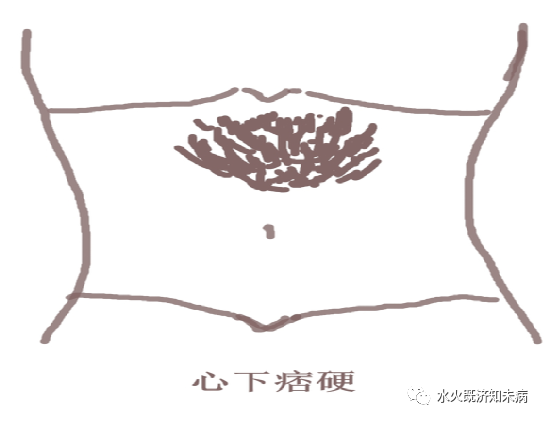 1. Hardness below the heart is an indication for the use of Ban Xia Xie Xin Tang, Gan Cao Xie Xin Tang, Sheng Jiang Xie Xin Tang, or Ren Shen Tang.2. Hardness below the heart may sometimes coexist with chest and rib fullness, which indicates the applicability of Xiao Chai Hu Tang and Da Chai Hu Tang.The method for examining hardness below the heart is to align the four fingers excluding the thumb and deeply palpate the abdomen. Typically, there is resistance without tenderness.(3) Firmness Below the Heart
1. Hardness below the heart is an indication for the use of Ban Xia Xie Xin Tang, Gan Cao Xie Xin Tang, Sheng Jiang Xie Xin Tang, or Ren Shen Tang.2. Hardness below the heart may sometimes coexist with chest and rib fullness, which indicates the applicability of Xiao Chai Hu Tang and Da Chai Hu Tang.The method for examining hardness below the heart is to align the four fingers excluding the thumb and deeply palpate the abdomen. Typically, there is resistance without tenderness.(3) Firmness Below the Heart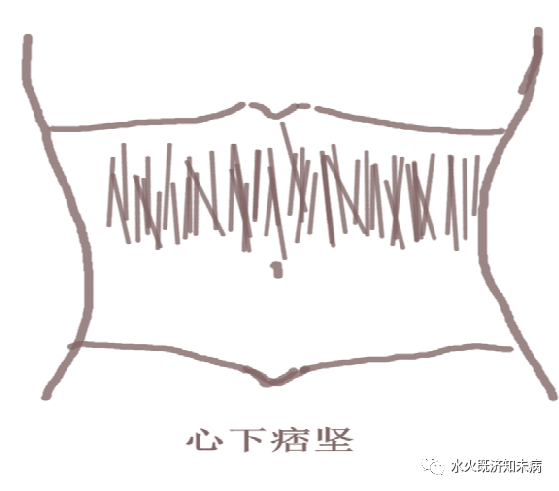 Firmness below the heart indicates that while there is resistance, it is often elastic; however, firmness below the heart indicates a hardness akin to a wooden board, with no elasticity, which is an indication for the use of Mu Fang Ji Tang.When examining hardness below the heart, it is important not to overlook the patient’s own symptoms of gastric fullness or epigastric obstruction. Additionally, middle-aged and obese women with significant subcutaneous fat may also exhibit hardness below the heart, which is often overlooked. Furthermore, if the abdominal wall appears soft and without resistance due to superficial subcutaneous fat, deeper resistance may still be palpable, which also indicates hardness below the heart. After eating, if there is hardness below the heart, it may become more pronounced, while those without hardness below the heart may present similar states.(4) Hardness Below the HeartThis is a subjective symptom. On objective examination, there is no resistance or tenderness. Those with hardness below the heart often have accompanying water sounds.(5) Abdominal Fullness
Firmness below the heart indicates that while there is resistance, it is often elastic; however, firmness below the heart indicates a hardness akin to a wooden board, with no elasticity, which is an indication for the use of Mu Fang Ji Tang.When examining hardness below the heart, it is important not to overlook the patient’s own symptoms of gastric fullness or epigastric obstruction. Additionally, middle-aged and obese women with significant subcutaneous fat may also exhibit hardness below the heart, which is often overlooked. Furthermore, if the abdominal wall appears soft and without resistance due to superficial subcutaneous fat, deeper resistance may still be palpable, which also indicates hardness below the heart. After eating, if there is hardness below the heart, it may become more pronounced, while those without hardness below the heart may present similar states.(4) Hardness Below the HeartThis is a subjective symptom. On objective examination, there is no resistance or tenderness. Those with hardness below the heart often have accompanying water sounds.(5) Abdominal Fullness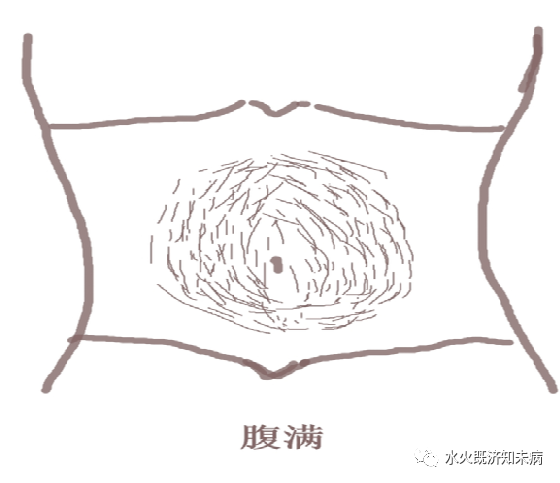 Abdominal fullness refers to a state of overall distension in the abdomen, which can be either deficiency or excess. If the abdomen is distended and elastic, with a deep and strong pulse, and a tendency towards constipation, this indicates an excess pattern, suitable for the use of Da Cheng Qi Tang, Xiao Cheng Qi Tang, or Fang Feng Tong Sheng San. Conversely, if the abdomen is distended but weak and without strength, with a weak or deep pulse, this indicates a deficiency pattern. Additionally, in cases of ascites or peritonitis, this is often a deficiency pattern, suitable for the use of Gui Zhi Shao Yao Tang, Xiao Jian Zhong Tang, Si Ni Tang, or Fen Xiao Tang.(6) Fullness Below the Heart, Hardness Below the HeartFullness below the heart differs from abdominal fullness, as it refers specifically to distension in the area below the heart. Hardness below the heart refers to a sensation of fullness in that area, but distinguishing between fullness below the heart and hardness below the heart can be challenging. These abdominal syndromes are suitable for the use of Yin Chen Hao Tang, Ling Gui Zhu Gan Tang, Fu Ling Ze Xie Tang, Wu Ling San, Fu Ling Yin, or Ban Xia Hou Po Tang.(7) Chest and Rib Fullness
Abdominal fullness refers to a state of overall distension in the abdomen, which can be either deficiency or excess. If the abdomen is distended and elastic, with a deep and strong pulse, and a tendency towards constipation, this indicates an excess pattern, suitable for the use of Da Cheng Qi Tang, Xiao Cheng Qi Tang, or Fang Feng Tong Sheng San. Conversely, if the abdomen is distended but weak and without strength, with a weak or deep pulse, this indicates a deficiency pattern. Additionally, in cases of ascites or peritonitis, this is often a deficiency pattern, suitable for the use of Gui Zhi Shao Yao Tang, Xiao Jian Zhong Tang, Si Ni Tang, or Fen Xiao Tang.(6) Fullness Below the Heart, Hardness Below the HeartFullness below the heart differs from abdominal fullness, as it refers specifically to distension in the area below the heart. Hardness below the heart refers to a sensation of fullness in that area, but distinguishing between fullness below the heart and hardness below the heart can be challenging. These abdominal syndromes are suitable for the use of Yin Chen Hao Tang, Ling Gui Zhu Gan Tang, Fu Ling Ze Xie Tang, Wu Ling San, Fu Ling Yin, or Ban Xia Hou Po Tang.(7) Chest and Rib Fullness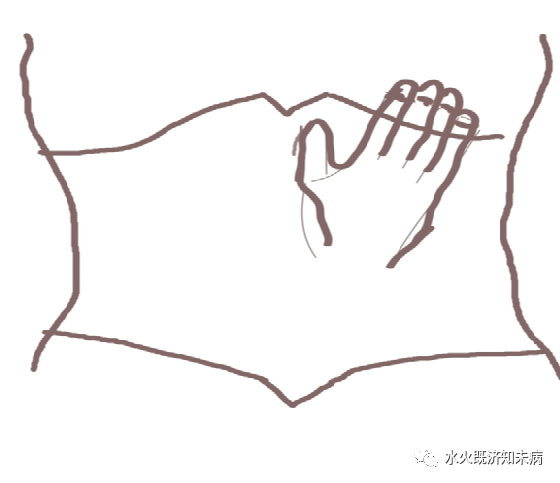 Chest and rib fullness refers to the patient’s own sensation of fullness in the chest and rib area. During objective examination, the physician should press from below the ribs towards the thoracic cavity as illustrated. If chest and rib fullness is present, there will be resistance felt by the fingertips, and the patient may experience difficulty breathing and report pain. However, the degree of resistance and pain will vary based on the severity of chest and rib fullness.Chest and rib fullness may appear on both sides or may be present on one side only, with the right side being more common. Additionally, conditions such as liver enlargement or cholecystitis may also present with chest and rib fullness, but this symptom can also be encountered in the absence of these diseases. Chest and rib fullness is an important target for formulas containing Chai Hu. If the illustrated chest and rib fullness is present, it indicates the applicability of Xiao Chai Hu Tang.
Chest and rib fullness refers to the patient’s own sensation of fullness in the chest and rib area. During objective examination, the physician should press from below the ribs towards the thoracic cavity as illustrated. If chest and rib fullness is present, there will be resistance felt by the fingertips, and the patient may experience difficulty breathing and report pain. However, the degree of resistance and pain will vary based on the severity of chest and rib fullness.Chest and rib fullness may appear on both sides or may be present on one side only, with the right side being more common. Additionally, conditions such as liver enlargement or cholecystitis may also present with chest and rib fullness, but this symptom can also be encountered in the absence of these diseases. Chest and rib fullness is an important target for formulas containing Chai Hu. If the illustrated chest and rib fullness is present, it indicates the applicability of Xiao Chai Hu Tang. However, if the illustrated strong chest and rib fullness is present, it indicates the applicability of Da Chai Hu Tang.
However, if the illustrated strong chest and rib fullness is present, it indicates the applicability of Da Chai Hu Tang.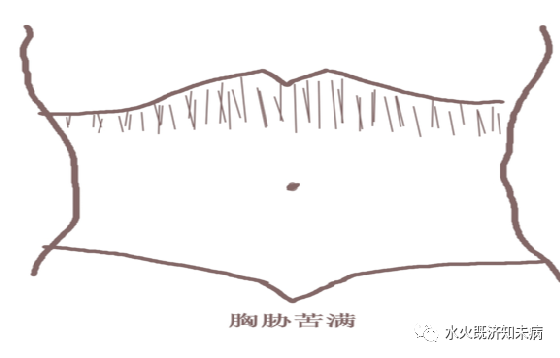 Furthermore, if there is chest and rib fullness along with tension in the rectus abdominis, this abdominal syndrome indicates the applicability of Chai Hu Gui Zhi Tang. If there is also chest and rib fullness with increased pulsation around the navel, this indicates the applicability of Chai Hu Jia Long Gu Mu Li Tang or Chai Hu Gui Zhi Gan Jiang Tang.
Furthermore, if there is chest and rib fullness along with tension in the rectus abdominis, this abdominal syndrome indicates the applicability of Chai Hu Gui Zhi Tang. If there is also chest and rib fullness with increased pulsation around the navel, this indicates the applicability of Chai Hu Jia Long Gu Mu Li Tang or Chai Hu Gui Zhi Gan Jiang Tang.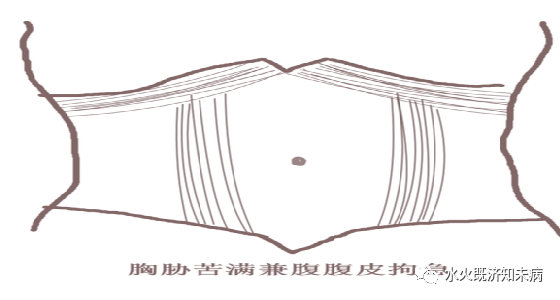 (8) Abdominal Rigidity (Rectus Abdominis Tension)In ancient texts, abdominal rigidity refers to the tension of the rectus abdominis. Additionally, ancient texts refer to “internal urgency,” which also includes tension of the rectus abdominis.Tension in the rectus abdominis can occur bilaterally, or one side may be stronger than the other; there may also be tension in the upper part without tension in the lower part, or vice versa.The illustrated tension in the rectus abdominis indicates the applicability of Xiao Jian Zhong Tang, Huang Qi Jian Zhong Tang, Shao Yao Gan Cao Tang, or Gui Zhi Jia Shao Yao Tang.
(8) Abdominal Rigidity (Rectus Abdominis Tension)In ancient texts, abdominal rigidity refers to the tension of the rectus abdominis. Additionally, ancient texts refer to “internal urgency,” which also includes tension of the rectus abdominis.Tension in the rectus abdominis can occur bilaterally, or one side may be stronger than the other; there may also be tension in the upper part without tension in the lower part, or vice versa.The illustrated tension in the rectus abdominis indicates the applicability of Xiao Jian Zhong Tang, Huang Qi Jian Zhong Tang, Shao Yao Gan Cao Tang, or Gui Zhi Jia Shao Yao Tang.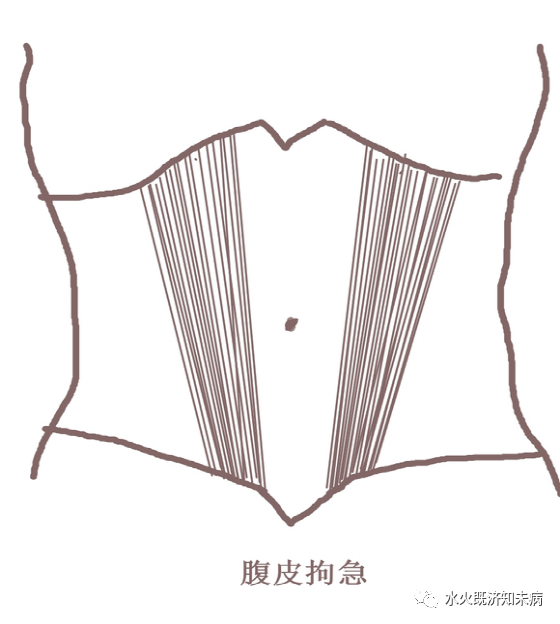 Furthermore, if the tension is in the upper part of the rectus abdominis, it indicates the applicability of Si Ni San (with chest and rib fullness) or Yi Gan San.
Furthermore, if the tension is in the upper part of the rectus abdominis, it indicates the applicability of Si Ni San (with chest and rib fullness) or Yi Gan San.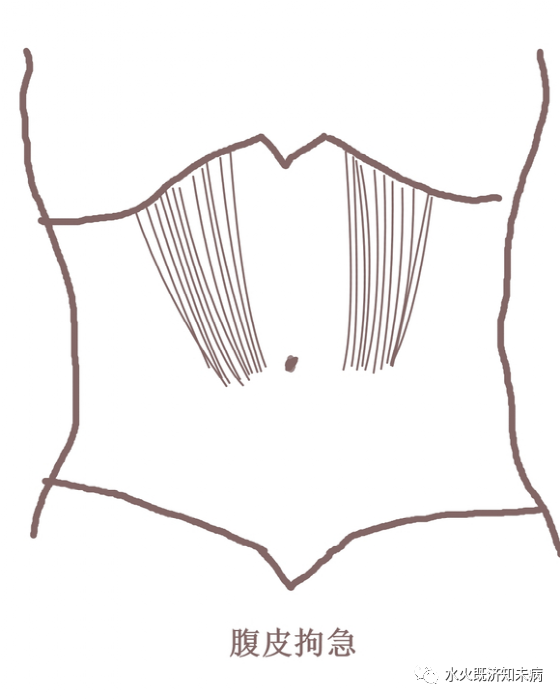 (9) Lower Abdominal Rigidity, Lower Abdominal String TensionThe “Jin Kui Yao Lue” states: “For deficiency and fatigue, with low back pain, lower abdominal rigidity, and difficulty urinating, Ba Wei Shen Qi Wan is the main treatment.” Lower abdominal rigidity is illustrated as follows.
(9) Lower Abdominal Rigidity, Lower Abdominal String TensionThe “Jin Kui Yao Lue” states: “For deficiency and fatigue, with low back pain, lower abdominal rigidity, and difficulty urinating, Ba Wei Shen Qi Wan is the main treatment.” Lower abdominal rigidity is illustrated as follows. In the lower abdomen, it feels as if the rectus abdominis is being pulled, indicating a hard and tense state, which is an indication for Ba Wei Wan.Additionally, lower abdominal rigidity and lower abdominal string tension are very similar and difficult to distinguish. Although both involve tension in the rectus abdominis in the lower abdomen, the illustrated lower abdominal string tension indicates that the tension extends upwards, especially if the lower part is more tense.(10) Numbness in the Lower AbdomenNumbness in the lower abdomen refers to a state of weakness in the lower abdomen, as illustrated. This is also an abdominal syndrome for Ba Wei Wan.
In the lower abdomen, it feels as if the rectus abdominis is being pulled, indicating a hard and tense state, which is an indication for Ba Wei Wan.Additionally, lower abdominal rigidity and lower abdominal string tension are very similar and difficult to distinguish. Although both involve tension in the rectus abdominis in the lower abdomen, the illustrated lower abdominal string tension indicates that the tension extends upwards, especially if the lower part is more tense.(10) Numbness in the Lower AbdomenNumbness in the lower abdomen refers to a state of weakness in the lower abdomen, as illustrated. This is also an abdominal syndrome for Ba Wei Wan.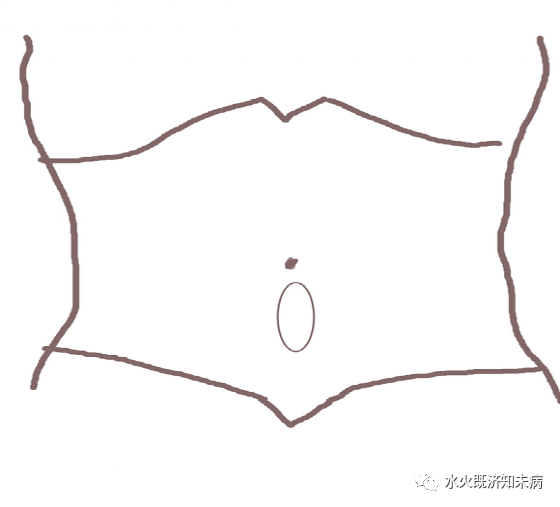 Thus, the abdominal syndrome of Ba Wei Wan includes lower abdominal rigidity as illustrated, lower abdominal weakness, and the presence of central resistance.Finally, the diagnosis and treatment of abdominal conditions in TCM require a comprehensive understanding of the symptoms and their interrelations. This platform is dedicated to sharing knowledge of TCM; friends who are interested in TCM are encouraged to follow and share!!!
Thus, the abdominal syndrome of Ba Wei Wan includes lower abdominal rigidity as illustrated, lower abdominal weakness, and the presence of central resistance.Finally, the diagnosis and treatment of abdominal conditions in TCM require a comprehensive understanding of the symptoms and their interrelations. This platform is dedicated to sharing knowledge of TCM; friends who are interested in TCM are encouraged to follow and share!!! 

